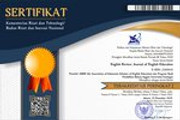FOSTERING QUALITATIVE CONTENT ANALYSIS SKILLS THROUGH CASE METHOD
Abstract
This study is aimed at demonstrating how students in the University of Bengkulu's master's program in Indonesian language education have improved their capacity to employ qualitative content analysis techniques. This study uses a classroom action research method with the Kemmis and MC model. Data collection techniques using observation, interviews, tests, and documentation. Data analysis techniques are: 1) analyzing qualitative data, namely observation data, interviews, and document analysis; 2) analyzing quantitative data, namely performance test data, and 3) interpreting and setting indicators of success of actions. Test the validity of the data using the technique of inter rater, member check, and triangulation of data sources. The results showed that the application of case method carried out online through Zoom Cloud Meetings and LMS University of Bengkulu was able to improve the ability to use qualitative content analysis methods for students. Improvement both in terms of the learning process that activates the learning experience through solving discourse analysis cases at the level of knowledge and activities trying to analyze class discourse, as well as increasing learning outcomes in the first cycle by 16% which reached a value of 80, increasing in cycle 2 by 91.66% which reaches a value of 80.
Keywords
Full Text:
PDFReferences
Adila, I., Weda, W. & Tamitiadini, D. (2019). Pengembangan model literasi dan informasi berbasis Pancasila dalam menangkal Hoaks. Wacana: Jurnal Ilmiah Ilmu Komunikasi, 18(1). 101-111.
Arends, R. I. (2008). Learning to Teach Belajar untuk Mengajar. Terjemahan Helly Pajitno Soetjipto & Sri Mulyantini Soetjipto. Pustaka Pelajar.
Choi, A., & Kim, C. (2019). Characteristics of European and American senior tourists visiting korea: focused on content analysis method of mayring. Journal of Tourism and Leisure Research, 31(12), 123–145. doi:10.31336/jtlr.2019.12.31.12.123
Corvo, E., & De Caro, W. (2020). Covid-19 and newspapers: A content & text mining analysis. European Journal of Public Health, 30(5). September 2020,
Emzir. (2014). Metodologi Penelitian Kualitatif Analisis Data. PT RajaGrafindo Persada.
Eriyanto. (2011). Analisis Isi: Pengantar Metodologi untuk Penelitian Ilmu Komunikasi dan Ilmu-ilmu Soisal Lainnya. Kencana.
Greiff, S., Holt, D. V., & Funke, J. (2013). Perspectives on problem solving in educational assessment: analytical, interactive, and collaborative problem solving. The Journal of Problem Solving, 5(2), 71-91. doi:10.7771/1932-6246.1153
Gulo, W. (2002). Strategi Belajar Mengajar. PT. Grasindo.
Karto., Suhartono., Susetyo., Noermanzah., & Maisarah, I. (2019). The differences ability in writing descriptive texts by using chain writing and conventional methods. International Journal of Scientific & Technology Research, 8(10), 2718.
Kemmis, S., McTaggart, R. & Nixon, R. (2014). The Action Research Planner. Springer. Available at: http://dx.doi.org/10.1007/978-981-4560-67-2
Krippendorff, K. (2004). Content Analysis: An Introduction to Its Methodology. Sage Publication.
Kusrianti, A., & Suharto, V. T. (2019). Penerapan model pembelajaran problem based learning dengan multimedia untuk meningkatkan kemampuan menulis puisi siswa. Linguista: Jurnal Ilmiah Bahasa, Sastra, dan Pembelajarannya, 3(2), 149. doi:10.25273/linguista.v3i2.5736
Kuzle, A. (2015). Problem solving as an instructional method: The use of open problems in technology problem solving instruction. Lumat: International Journal of Math, Science and Technology Education, 3(1), 69–86. doi:10.31129/lumat.v3i1.1052
Mayring, P. (2000). Qualitative Content Analysis. Forum Qualitative Social Research.
Mayring, P. (2014). Qualitative content analysis: theoretical background and procedures. Approaches to Qualitative Research in Mathematics Education. Springer. 365–380. doi:10.1007/978-94-017-9181-6_13.
Mayring, P. (2014). Qualitative Content Analysis: Theoretical Foundation, Basic Procedures and Software Solution. Gesis.
Minister of Education and Culture of the Republic of Indonesia Number 3/M/2021 on Key Performance Indicators of State Universities and Higher Education Service Institutions at the Ministry of Education and Culture. Minister of Education and Culture of the Republic of Indonesia.
Nisa, K A. (2018). Problem based learning dalam meningkatkan kemampuan menulis karya ilmiah mahasiswa. Jurnal Petik, 2(1), 24-35. doi:10.31980/jpetik.v2i1.63.
Noermanzah, N. & Suryadi, N. (2020). Improving students ability to analyze discourse through the moodle-based blended learning method. English Review: Journal of English Education, 9(1), 83-85.
Rumata, V. M. (2017). Analisis isi kualitatif twitter “#TaxAmnesy” dan “#AmnestiPajak.” Jurnal Penelitian Komunikasi dan Pembangunan, 18(1), 1-18. doi:10.31346/jpkp.v18i1.840.
Sakila, S. (2019). Metode pemecahan berbasis masalah pada pembelajaran menulis teks deskripsi. Genta Bahtera: Jurnal Ilmiah Kebahasaan dan Kesastraan, 5(1), 1–17. doi:10.47269/gb.v5i1.77
Sitepu, D. S. (2018). Pengaruh metode problem solving dan kesiapan belajar siswa terhadap hasil belajar PAK di Kelas XI SMA Negeri 2 Balige. School Education Journal, 9(1), 35–44. doi:10.24114/sejpgsd.v9i1.13686
Sukesti, L. A. (2020). Peningkatan kemampuan berbicara teks hortatory exposition menggunakan problem based learning dengan presentasi berbantuan film. Jurnal Guru Dikmen dan Diksus, 3(2), 169–185. doi:10.47239/jgdd.v3i2.239
Sumarno, S. (2020). Analisis isi dalam penelitian pembelajaran bahasa dan sastra. Edukasi Lingua Sastra, 18(2), 36–55. doi:10.47637/elsa.v18i2.299
Thomas, R. D. (2006). A general inductive approach for analyzing qualitative evaluation data. American Journal of Evaluation. 27(2): 237-242. DOI: 10.1177/1098214005283748
Yee, S. F. (2019). Teacher Professional Development and The Case Method. Springer.
Yenrizal, Y. (2018). Makna lingkuungan hidup di masa Sriwijaya: Analisis isi pada prasasti Talang Tuwo. Jurnal Aspikom, 3(5), 833-845. doi:10.24329/aspikom.v3i5.302.
DOI: https://doi.org/10.25134/erjee.v10i2.6312
Refbacks
- There are currently no refbacks.
Copyright (c) 2022 English Review: Journal of English Education

